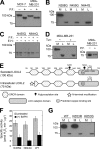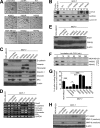MCF-7 cells expressing nuclear associated lysyl oxidase-like 2 (LOXL2) exhibit an epithelial-to-mesenchymal transition (EMT) phenotype and are highly invasive in vitro
- PMID: 24014025
- PMCID: PMC3798469
- DOI: 10.1074/jbc.C113.502310
MCF-7 cells expressing nuclear associated lysyl oxidase-like 2 (LOXL2) exhibit an epithelial-to-mesenchymal transition (EMT) phenotype and are highly invasive in vitro
Abstract
LOXL2 is a copper- and lysine tyrosylquinone-dependent amine oxidase that has been proposed to function both extracellularly and intracellularly to activate oncogenic signaling pathways leading to EMT and invasion of breast cancer cells. In this study, we selected MCF-7 cells that stably express forms of recombinant LOXL2 differing in their subcellular localizations and catalytic competencies. This enabled us to dissect the molecular functions of intracellular and extracellular LOXL2s and examine their contributions to breast cancer metastasis/invasion. We discovered that secreted LOXL2 (~100-kDa) is N-glycosylated at Asn-455 and Asn-644, whereas intracellular LOXL2 (~75-kDa) is nonglycosylated and N-terminally processed, and is primarily associated with the nucleus. Both forms of LOXL2 can oxidize lysine in solution. However, we found that expression of intracellular LOXL2 is more strongly associated with EMT and invasiveness than secreted LOXL2 in vitro. The results indicate that nuclear associated LOXL2 contributes to the stabilization of Snail1 transcription factor at the protein level to induce EMT and promote invasion in vitro, through repression of E-cadherin, occludin, and estrogen receptor-α, and up-regulation of vimentin, fibronectin, and MT1-MMP.
Keywords: Breast Cancer; Cell Invasion; Epithelial-to-mesenchymal Transition; Lysyl Oxidase; Lysyl Oxidase-Like 2; Post-translational Modification; Site-directed Mutagenesis.
Figures


Similar articles
-
LOXL2 expression is associated with invasiveness and negatively influences survival in breast cancer patients.Breast Cancer Res Treat. 2013 Aug;141(1):89-99. doi: 10.1007/s10549-013-2662-3. Epub 2013 Aug 10. Breast Cancer Res Treat. 2013. PMID: 23933800 Free PMC article.
-
Lysyl oxidase-like 2 (LOXL2) and E47 EMT factor: novel partners in E-cadherin repression and early metastasis colonization.Oncogene. 2015 Feb 19;34(8):951-64. doi: 10.1038/onc.2014.23. Epub 2014 Mar 17. Oncogene. 2015. PMID: 24632622
-
LOXL2 in cancer: regulation, downstream effectors and novel roles.Biochim Biophys Acta Rev Cancer. 2020 Dec;1874(2):188435. doi: 10.1016/j.bbcan.2020.188435. Epub 2020 Sep 22. Biochim Biophys Acta Rev Cancer. 2020. PMID: 32976981 Review.
-
Novel mechanism for OSM-promoted extracellular matrix remodeling in breast cancer: LOXL2 upregulation and subsequent ECM alignment.Breast Cancer Res. 2021 May 19;23(1):56. doi: 10.1186/s13058-021-01430-x. Breast Cancer Res. 2021. PMID: 34011405 Free PMC article.
-
Human lysyl oxidase-like 2.Bioorg Chem. 2014 Dec;57:231-241. doi: 10.1016/j.bioorg.2014.07.003. Epub 2014 Aug 1. Bioorg Chem. 2014. PMID: 25146937 Free PMC article. Review.
Cited by
-
Extracellular Processing of Lysyl Oxidase-like 2 and Its Effect on Amine Oxidase Activity.Biochemistry. 2018 Dec 26;57(51):6973-6983. doi: 10.1021/acs.biochem.8b01008. Epub 2018 Dec 13. Biochemistry. 2018. PMID: 30499665 Free PMC article.
-
Lysyl oxidase like-2 in fibrosis and cardiovascular disease.Am J Physiol Cell Physiol. 2023 Sep 1;325(3):C694-C707. doi: 10.1152/ajpcell.00176.2023. Epub 2023 Jul 17. Am J Physiol Cell Physiol. 2023. PMID: 37458436 Free PMC article. Review.
-
Reciprocal regulation of LOXL2 and HIF1α drives the Warburg effect to support pancreatic cancer aggressiveness.Cell Death Dis. 2021 Nov 26;12(12):1106. doi: 10.1038/s41419-021-04391-3. Cell Death Dis. 2021. PMID: 34836938 Free PMC article.
-
Anabolic role of lysyl oxidase like-2 in cartilage of knee and temporomandibular joints with osteoarthritis.Arthritis Res Ther. 2017 Aug 2;19(1):179. doi: 10.1186/s13075-017-1388-8. Arthritis Res Ther. 2017. PMID: 28764769 Free PMC article.
-
LOXL2 promotes aggrecan and gender-specific anabolic differences to TMJ cartilage.Sci Rep. 2020 Nov 19;10(1):20179. doi: 10.1038/s41598-020-77178-9. Sci Rep. 2020. PMID: 33214607 Free PMC article.
References
-
- Csiszar K. (2001) Lysyl oxidases: a novel multifunctional amine oxidase family. Prog. Nucleic Acid Res. Mol. Biol. 70, 1–32 - PubMed
-
- Smith-Mungo L. I., Kagan H. M. (1998) Lysyl oxidase: properties, regulation and multiple functions in biology. Matrix Biol. 16, 387–398 - PubMed
-
- Wang S. X., Mure M., Medzihradszky K. F., Burlingame A. L., Brown D. E., Dooley D. M., Smith A. J., Kagan H. M., Klinman J. P. (1996) A crosslinked cofactor in lysyl oxidase: redox function for amino acid side chains. Science 273, 1078–1084 - PubMed
-
- Akiri G., Sabo E., Dafni H., Vadasz Z., Kartvelishvily Y., Gan N., Kessler O., Cohen T., Resnick M., Neeman M., Neufeld G. (2003) Lysyl oxidase-related protein-1 promotes tumor fibrosis and tumor progression in vivo. Cancer Res. 63, 1657–1666 - PubMed
-
- Kirschmann D. A., Seftor E. A., Fong S. F., Nieva D. R., Sullivan C. M., Edwards E. M., Sommer P., Csiszar K., Hendrix M. J. (2002) A molecular role for lysyl oxidase in breast cancer invasion. Cancer Res. 62, 4478–4483 - PubMed
Publication types
MeSH terms
Substances
Grants and funding
LinkOut - more resources
Full Text Sources
Other Literature Sources
Medical
Molecular Biology Databases
Research Materials

